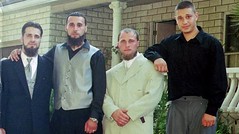One is a bankrupt convicted felon who spewed venomous hatred about the United States, hooked up an alleged terrorist cell with semiautomatic weapons and drove the surveillance car as they cased military bases. The other boasted of killing someone back home in Albania and vowed to kill others or blow himself up in a crowd of people now that he was in the United States.
The Government says it has plenty of tapes to prove its case and isn't relying solely on the snitch testimony.
Legal experts say the trial will test the use of "cold inserts," informants who insinuate themselves into a group of suspects, usually for money or in exchange for making legal or immigration problems disappear. It is a controversial tactic that has been used with increasing frequency and some success since Sept. 11. Critics say it has the potential for far more abuse than the traditional law enforcement tactic of "flipping" someone who is already part of a conspiracy.
Defense lawyers say the informants skillfully took the anger and Islamic fervor of hotheaded young men and twisted it into a terrorist plot so that they could get paid a lot of money, get out of legal trouble and possibly avoid deportation from the United States.
The charges include attempted murder, conspiracy to murder military personnel and assorted weapons charges.
Among the defense witnesses is a former DEA agent who supervised informants for over 30 years.
[Gregory D.]Lee said that an "inordinate" number of conversations went untaped by Omar and that during other conversations Omar turned the hidden recorder on and off -- possibly downplaying or excluding potentially exculpatory evidence and manipulating what was recorded to make the defendants look guilty.
He also wrote that a close acquaintance of Omar now says that while undercover, Omar "continued to commit crimes, including but not limited to defrauding persons in business transactions and obtaining and using illegal drugs."
He continued: "Indeed . . . [Omar] revealed his cooperating status to this person and even demonstrated evading cameras in his home while engaging in the use of illegal drugs during the course of the investigation so his handlers would not find out."
As I wrote back in May, 2007 when the New York Times wrote about the informants in the case,
Did [the informants] merely facilitate plans already in the minds of the defendants? Or, did they engineer and create the crimes? ....Would the defendants have acted on their interests but for the provocation of the informer? Was it just talk, with the action being taken by the informer?
We don't know yet, but it's something to keep in mind in following the case.
More background here and here.
Update: Description of Government's opening argument this morning here.
"Their motive was to defend Islam. Their inspiration was al-Qaida and Osama bin Laden. Their intent was to kill members of the United States armed services," Deputy U.S. Attorney William Fitzpatrick told the jury of eight women and four men.




